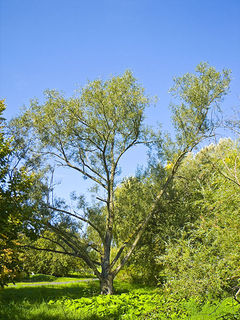Salix fragilis: Difference between revisions
No edit summary |
No edit summary |
||
| Line 1: | Line 1: | ||
{{Inc| | |||
Salix fragilis, Linn. (S. viridis, Fries. S. Russelliana, Smith). Brittle Willow. Fig. 3526. Tree, 50-60 ft. high, excurrent in habit and of very rapid growth: branches brown, obliquely ascending: buds medium size, pointed: lvs. large, lanceolate-acuminate, glabrous or slightly hairy when young, scarcely paler beneath, glandular serrate: aments appearing with the lvs. (the staminate tree rare in Amer.), seldom bearing good seed, slender; scales deciduous. Eu., N. Asia. Gn. 19, p. 517; 55, p. 89.—Frequently cult. and also growing spontaneously in many places. A company of promoters induced many American farmers to plant hedges of this willow some 50 years ago. Many of these occur now throughout the country, the trees being 40-50 ft. high. A stake cut from a tree and driven in the ground will soon establish itself and grow into a tree. Var. decipiens, Hoffm. Twigs yellow: buds black in winter: lvs. smaller and brighter green. Probably a hybrid with another species. | |||
}} | |||
{{Taxobox | {{Taxobox | ||
| color = lightgreen | | color = lightgreen | ||
Revision as of 12:23, 30 April 2009
| Standard Cyclopedia of Horticulture |
|---|
|
Salix fragilis, Linn. (S. viridis, Fries. S. Russelliana, Smith). Brittle Willow. Fig. 3526. Tree, 50-60 ft. high, excurrent in habit and of very rapid growth: branches brown, obliquely ascending: buds medium size, pointed: lvs. large, lanceolate-acuminate, glabrous or slightly hairy when young, scarcely paler beneath, glandular serrate: aments appearing with the lvs. (the staminate tree rare in Amer.), seldom bearing good seed, slender; scales deciduous. Eu., N. Asia. Gn. 19, p. 517; 55, p. 89.—Frequently cult. and also growing spontaneously in many places. A company of promoters induced many American farmers to plant hedges of this willow some 50 years ago. Many of these occur now throughout the country, the trees being 40-50 ft. high. A stake cut from a tree and driven in the ground will soon establish itself and grow into a tree. Var. decipiens, Hoffm. Twigs yellow: buds black in winter: lvs. smaller and brighter green. Probably a hybrid with another species.
|
| Crack Willow secure Fossil range: {{{fossil_range}}}
| ||||||||||||||||||||||||||||||||||||||||||||||||||||||||||||||||||
|---|---|---|---|---|---|---|---|---|---|---|---|---|---|---|---|---|---|---|---|---|---|---|---|---|---|---|---|---|---|---|---|---|---|---|---|---|---|---|---|---|---|---|---|---|---|---|---|---|---|---|---|---|---|---|---|---|---|---|---|---|---|---|---|---|---|---|
 Crack Willow | ||||||||||||||||||||||||||||||||||||||||||||||||||||||||||||||||||
| Plant Info | ||||||||||||||||||||||||||||||||||||||||||||||||||||||||||||||||||
| ||||||||||||||||||||||||||||||||||||||||||||||||||||||||||||||||||
| Scientific classification | ||||||||||||||||||||||||||||||||||||||||||||||||||||||||||||||||||
| ||||||||||||||||||||||||||||||||||||||||||||||||||||||||||||||||||
| [[{{{diversity_link}}}|Diversity]] | ||||||||||||||||||||||||||||||||||||||||||||||||||||||||||||||||||
| {{{diversity}}} | ||||||||||||||||||||||||||||||||||||||||||||||||||||||||||||||||||
| Binomial name | ||||||||||||||||||||||||||||||||||||||||||||||||||||||||||||||||||
| Salix fragilis L. | ||||||||||||||||||||||||||||||||||||||||||||||||||||||||||||||||||
| Trinomial name | ||||||||||||||||||||||||||||||||||||||||||||||||||||||||||||||||||
| {{{trinomial}}} | ||||||||||||||||||||||||||||||||||||||||||||||||||||||||||||||||||
| Type Species | ||||||||||||||||||||||||||||||||||||||||||||||||||||||||||||||||||
| {{{type_species}}} | ||||||||||||||||||||||||||||||||||||||||||||||||||||||||||||||||||
| {{{subdivision_ranks}}} | ||||||||||||||||||||||||||||||||||||||||||||||||||||||||||||||||||
| [[Image:{{{range_map}}}|{{{range_map_width}}}|]] | ||||||||||||||||||||||||||||||||||||||||||||||||||||||||||||||||||
| Synonyms | ||||||||||||||||||||||||||||||||||||||||||||||||||||||||||||||||||
| {{{synonyms}}} |
The Crack Willow (Salix fragilis) is a willow native to Europe and Asia, and is reportedly invasive in North America. It is a medium-sized to large deciduous tree, which grows rapidly and can be up to 27 m tall. Its preferred habitat is beside rivers. The leaves are bright green, 9-15 cm long and 1.5-3 cm wide, with a finely serrated margin. The dioecious flowers are catkins, produced in early spring, and pollinated by bees.
The name derives from the twigs which break off very easily and cleanly at the base with an audible crack. The broken twigs and branches take root readily, enabling the species to colonise new areas, particularly where the broken twigs fall into rivers and can be carried some distance downstream. It is particularly adept at colonising new riverside sandbanks formed after floods.
Its female flowers can have either one or two nectaries.